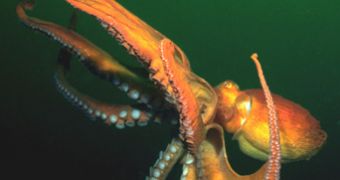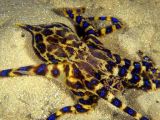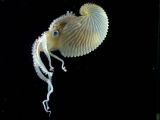The history of the cephalopods ("head-foot") mollusks started about 500 million years ago. Towards the end of the Cretaceous (the last dinosaur era) the first octopuses appeared, still with an inner shell and being very small (8 cm long). Today there are 289 species of octopuses, forming about one third of the all cephalopod species.
The largest octopus in the world is the North Pacific Giant Octopus (Octopus dofleini). This species measures on average 3 m (10 ft) in length and weighs 15 kg (33.3 pounds), but in 1957 an individual of almost 10 m (30 ft) and 272 kg (604 pounds) in weight was brought by the waves on the beaches of the British Columbia (western Canada). The octopuses of western Canada achieve the huge size due to the soft climate and the waters abundant in food. The size of 3 m is achieved in three years.
The males of the argonaut octopuses are 2 cm (0.8 inch) long, while the female is huge with her maximum 10 cm (4 inch) in length.
Octopuses are agile hunters, eating mainly crustaceans (crabs and lobsters) and mollusks, sometimes fish (including sharks). Still they can pass a 6-month fasting.
They usually mate just once in a lifetime: the female deposes about 150-300,000 eggs which are defended and oxygenated by the mother with spray of water for 50 days, a time when she eats nothing. She survives from her fat reserves. When the offspring hatch, the female dies of starvation. This reproduction, for which the female offers even the last breath, is also found in octopuses' relatives, squids and cuttlefish.
Here are 10 facts that make octopuses special creatures:
1.Their intelligence is amazing. Their brain is formed by 500 million large neurons (the human brain contains about 100 billion smaller neurons). People thought for long that their intelligence was comparable with that of a cat. But if a cat needs to get the reflex of opening a door after having seen the action many times, an octopus can find the solution by itself, having "conceptual thinking". An octopus opens the plug of a bottle to get to the lobster inside. Besides mammals and birds, octopuses are the only animals known to play.
Octopuses are solitary and the young must take care of themselves soon after hatching, using a learning process not based on direct transmission. The speed of learning is amazing: an octopus learnt by itself in about 12 minutes how to get off from a cage. The next time it was put in the cage, it went out in 90 seconds! This means analysis ability and an amazing memory. Octopuses have two memories, one cerebral (located in their brain) and one linked directly to their cups.
All scuba divers know how curious octopuses can be, a clear sign of intelligence.
Octopuses live just 3-5 years, a fact that limits their abilities of accumulating information. Many believe that if octopuses had lived more, they would have been the dominant intelligence on Earth.
2.They can change body shape to escape traps. The only solid party of an octopus body is its cartilaginous "skull". So, if a hole allows the passing of the skull, the octopus will evade. This ability causes many troubles in aquariums.
3.The octopus's eye is the most complex amongst invertebrates, very similar structurally and functionally to the human eye.
4.They have three hearts, but the vascular system is weak and lifespan short.
5.An octopus' penis, formed by the male's third arm and called hectocotylus, is detachable. After one mating, when the male loses its hectocotylus, it won't be able to copulate again till the next season, when a new hectocotylus re-grows.
In the case of the common type of octopuses, males die within few months after mating, without regenerating another hectocotylus. In argonaut octopuses, the male does not even approach the female. When the spermatophores are formed, the hectocotylus breaks off from the male while away from the female, heading towards her and entering alone into its mantle cavity to fecundate the eggs. The argonaut octopuses are also called paper nautiluses, referring to the paper-thin eggcase that females secrete. This structure lacks the gas-filled chambers present in chambered nautilus shells (an extremely primitive relict cephalopod) and is not a true cephalopod shell, but an evolutionary innovation unique to these octopuses.
6.The 1,600 cups found in the arms are not just tactile organs, but also olfactory. In other words, octopuses smell with their arms.
7.Octopuses have a mimetic ability much higher than that of a chameleon (in fact the chameleons are not that mimetic, they do not imitate their environment, they just change colors). Octopuses imitate not only the color, but also the texture, of, let's say, a stone covered by algae, so that it can hurl itself over its victim that does not even realize what's going on. This way they can also escape from predators, like seals.
8.When attacked by predators, octopuses can detach their arms. After a few weeks, the amputated arm will grow back.
9.The blue-ringed octopus (Hapalochlaena) can reach a maximum of 20 cm (8 inch) in length, weighing 26 grams. It is the size of a golf ball, but its venom contains powerful neurotoxins that kill humans. There is not any antidote for it.
10.The abyssal octopus called the Vampire Squid (Vampyroteuthis infernalis) is covered entirely with light-producing organs called photophores. The animal has great control over the organs, capable of producing disorienting flashes of light for fractions of a second to several minutes in duration.

 14 DAY TRIAL //
14 DAY TRIAL // 

